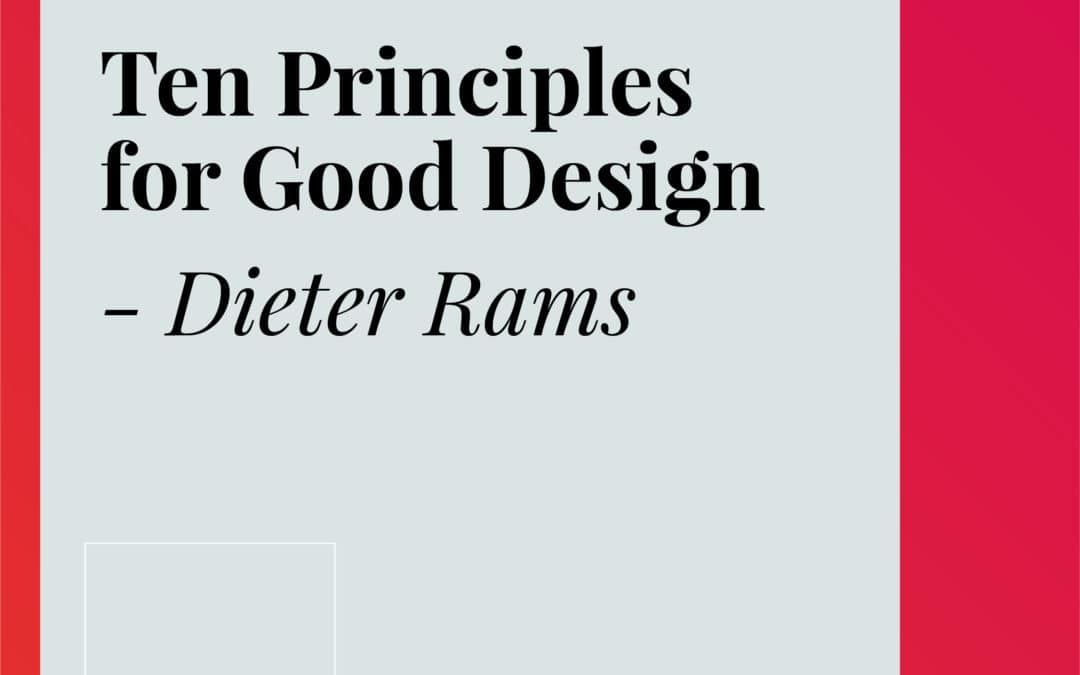Dieter Rams is a German industrial designer who was responsible for the design of Braun’s consumer products for many years. In the 1970’s, he asked the question “Is my design a good design?”, and as a result he developed the 10 principles of good design. Ram’s principles have stood the test of time and are still very relevant and valid in today’s design world.
Both consumer products and technology have changed tremendously over the decades. Even aesthetics have changed considerably and many of Rams’ designs look a little old-fashioned for most of us, or trendy if you’re a fan of ’60s and ’70s designs like myself. Despite all the advancements, the principles still remain a valuable guideline for anyone working in the design industry. Although they were initially created for product and industrial design, the principles of good design relate well across graphic and digital design. They are also relevant when creating a new product or service, which requires a solid brand presence and image.
So, let’s take a look at the ten principles, Ram’s take on them followed by how they are relevant to brand design today …
![]()
1. Good design is innovative
The possibilities for innovation are not, by any means, exhausted. Technological development is always offering new opportunities for innovative design. But innovative design always develops in tandem with innovative technology, and can never be an end in itself.
Get the brand design gist:
This means that there is simply no excuse not to innovate. Be forward thinking and imaginative and keep abreast with technology and how it can assist your design/product. This especially relates, in marketing and branding, to the digital platforms – making sure your brand evolves across the correct social platforms to attract the right audience. Think about using video/animation and make sure your logo and visual identity measures up against current trends. Your logo might remain constant, but your VI can evolve to suit trends and individual campaigns.
![]()
2. Good design makes a product useful
A product is bought to be used. It has to satisfy certain criteria, not only functional, but also psychological and aesthetic. Good design emphasises the usefulness of a product whilst disregarding anything that could possibly detract from it.
Get the brand design gist:
A product should have a function, and a specific function. It should work well above all and be clear with its intentions. Each marketing material has its own function – whether it be a flyer or a website – you want to it to create an action by its user. For example, a flyer’s function could be to raise brand awareness and also act as a CTA for the user to go to the website. A website’s primary function could be to bring in customers with SEO and once they are there, to purchase or book an appointment.
![]()
3. Good design is aesthetic
The aesthetic quality of a product is integral to its usefulness because products we use every day affect our person and our well-being. But only well-executed objects can be beautiful.
Get the brand design gist:
Ok – so we all know that looks matter. People make purchases based on emotion and perception, so the aesthetic has a psychological effect on whether they will be attracted to the product/service. If your design is clear, with the right focus, people are more likely to follow the function. If the design is busy, with too much text and no clear message, then the user may just skip over it. 80% of all impressions on our emotions are made by means of sight. So chose a great image, so there’s an immediate response to it. And remember, visual information is deciphered 60,000 times faster than plain text.
![]()
4. Good design makes a product understandable
It clarifies the product’s structure. Better still, it can make the product talk. At best, it is self-explanatory.
Get the brand design gist:
Having a solid brand strategy in place will help all people associated with the brand – internally and externally – gain a better understanding of its values, vision and mission. Employees will understand how they should behave and interact with customers due to the brand personality and brand story. Creatives use the brand strategy as an objective measure to produce visuals to tell the brand story. Consequently, the brand will be perceived in a positive and targeted way by its audience.
![]()
5. Good design is unobtrusive
Products fulfilling a purpose are like tools. They are neither decorative objects nor works of art. Their design should therefore be both neutral and restrained, to leave room for the user’s self-expression.
Get the brand design gist:
A brand should never be fixed to the point that it is unable to evolve. It should be a tool for understanding and guidance. A solid brand strategy should detail enough about the brand to be able to create multiple visuals and designs but still allow for individual expression.
![]()
6. Good design is honest
It does not make a product more innovative, powerful or valuable than it really is. It does not attempt to manipulate the consumer with promises that cannot be kept.
Get the brand design gist:
Transparency is key to trust and loyalty when building a brand. We should be honest with our users about what we’re delivering to them. Understanding a business’s brand values and personality helps all people involved keep the brand promise.
![]()
7. Good design is long-lasting
It avoids being fashionable and therefore never appears antiquated. Unlike fashionable design, it lasts many years – even in today’s throwaway society.
Get the brand design gist:
Designing for the sake of fashion is a dangerous. Yet, staying on trend and up to date with new technology is key to keeping a brand alive. Keeping your design clean and simple and in-line with brand values will help maintain longevity. If a good brand strategy is in place, then the brand will have room to evolve and stay in with the latest trends without appearing out-dated.
![]()
8. Good design is thorough down to the last detail
Nothing must be arbitrary or left to chance. Care and accuracy in the design process show respect towards the user.
Get the brand design gist:
This is where good designers are separated from excellent designers. Often the majority of time is not spent in the design stage, but in the brand strategy and planning phases. For a website, great importance should be placed on the user experience and navigation through the site as well as the design itself. Once solid strategic foundations have been laid, then there is a solid base to create the correct visuals.
![]()
9. Good design is environmentally friendly
Design makes an important contribution to the preservation of the environment. It conserves resources and minimises physical and visual pollution throughout the lifecycle of the product.
Get the brand design gist:
I love that Dieter considered this back in the 70’s. It feels even more relevant today. When thinking about your marketing materials, consider whether printed materials are required or whether digital marketing is sufficient to promote your business. For products, forward-thinking on how we can create products and services that assist our environment and also our way of living are key to its the success.
![]()
10. Good design is as little design as possible
Less, but better – because it concentrates on the essential aspects, and the products are not burdened with non-essentials. Back to purity, back to simplicity.
Get the brand design gist:
This is one of my mottos for sure. Simple design and empty space allows designs to breath. Over complicated designs become too difficult to take in – especially in today’s busy world where people’s attention spans are so short. You have an average of 9 seconds to make an impression, so make sure you create an immediate impact. Anything that doesn’t serve the user should be eliminated.
Examples of good design in some of our recent work





